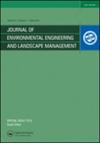EFFICIENCY LIMITING FACTORS OF PETROCHEMICAL WASTEWATER TREATMENT USING HYBRID BIOLOGICAL REACTOR
IF 1.1
4区 环境科学与生态学
Q4 ENVIRONMENTAL SCIENCES
Journal of Environmental Engineering and Landscape Management
Pub Date : 2022-10-07
DOI:10.3846/jeelm.2022.17633
引用次数: 1
Abstract
The wastewater characteristics and some operational control parameters limit the efficiency of attached growth processes for petrochemical wastewater treatment. This study aims to determine the efficiency of a hybrid biological reactor treating actual petrochemical wastewater and to identify the efficiency determining factors. An up-flow biological reactor filled with bio-career was operated at two flow rates, two dissolved oxygen (DO) levels, and under anaerobic conditions. Due to the varying characteristics of actual petrochemical wastewater, efficiency limitations were manifested in many ways. However, the highest chemical oxygen demand and biochemical oxygen demand (BOD) removal efficiencies were 77.2% and 78.5%, respectively, and were achieved under aerobic operation at organic loading rates (OLRs) of 0.2 kg-COD/m3/d and hydraulic retention time (HRT) of 26.67 h (DO 4.0 mg/l). Anaerobically, the highest efficiency was 41.7 for both at 0.18 kg-COD/m3/d and 400 ml/min. The total organic carbon (TOC) removal stability was attributed to the presence of toxic chemicals and removal mechanisms other than biodegradation, as it tapered off at high loading. The nutrient removal efficiency was marginal, conceivably due to the high organics to nutrient ratio and toxic conditions of the wastewater promoting nutrient removal inside the biofilm.混合生物反应器处理石油化工废水效率的限制因素
废水特性和一些操作控制参数限制了附着生长工艺处理石化废水的效率。本研究旨在确定混合生物反应器处理实际石化废水的效率,并确定效率的决定因素。在厌氧条件下,以两种流速、两种溶解氧(DO)水平操作填充有生物菌的上流式生物反应器。由于实际石化废水的特性不同,效率的局限性表现在很多方面。然而,化学需氧量和生化需氧量(BOD)的最高去除率分别为77.2%和78.5%,并且在有机负荷率(OLRs)为0.2 kg COD/m3/d和水力停留时间(HRT)为26.67 h(DO 4.0 mg/l)的好氧操作下实现。在0.18kg COD/m3/d和400ml/min条件下,厌氧处理的最高效率均为41.7。总有机碳(TOC)的去除稳定性归因于有毒化学物质的存在和除生物降解之外的去除机制,因为它在高负载下逐渐减少。可以想象,由于高有机物与营养物的比例和废水的有毒条件促进了生物膜内营养物的去除,因此营养物的清除效率是边际的。
本文章由计算机程序翻译,如有差异,请以英文原文为准。
求助全文
约1分钟内获得全文
求助全文
来源期刊
CiteScore
1.90
自引率
7.70%
发文量
41
审稿时长
>12 weeks
期刊介绍:
The Journal of Environmental Engineering and Landscape Management publishes original research about the environment with emphasis on sustainability.

 求助内容:
求助内容: 应助结果提醒方式:
应助结果提醒方式:


